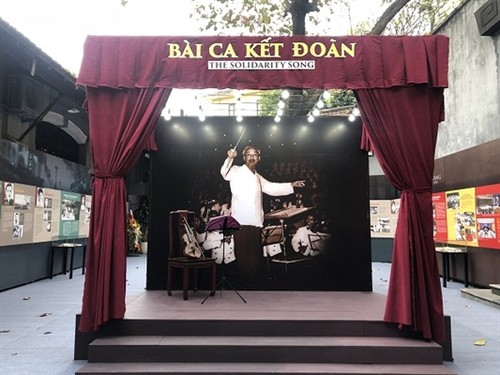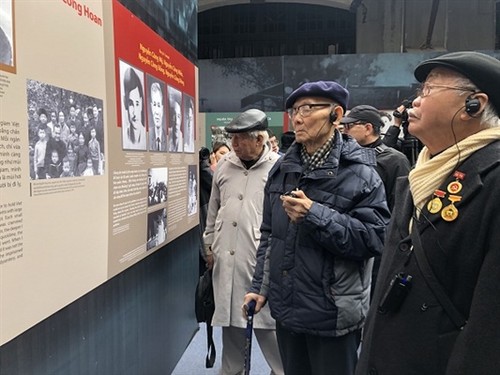 Picture of President Ho Chi Minh standing at the podium and conducting a choir singing the “Song of unity" (Photo: baovanhoa.vn) Picture of President Ho Chi Minh standing at the podium and conducting a choir singing the “Song of unity" (Photo: baovanhoa.vn) |
In the spotlight is the image of President Ho Chi Minh standing at the podium and conducting a choir singing the “Song of unity,” taken by photographer Lam Hong Long to celebrate the 3rd National Party Congress in 1960. Mr. Dao Doan The Hung, who was present that night, said the choir was in sync under the baton of Ho Chi Minh. He said, That was the very big choir singing the song “Congratulation to the Communist Party of Vietnam.” Ho Chi Minh said “now I will conduct the Song of Unity, can you sing it?" Everyone shouted yes. Then the President began to lift the baton.”
The exhibition is divided in two themes: Impression in the Countryside and Under the Glorious Party Flag. The Impression in the Countryside section tells stories about children who made great contributions to national liberation. From the poor rural areas, many patriots followed revolutions, volunteering to sacrifice personal happiness for national independence and freedom.
Mr. Tran Kham, Deputy Head of the Representative Committee of the Revolutionary Soldiers Imprisoned by the Enemy in Hanoi, told VOV, “It was very emotional to see the images of the revolutionary veterans who were imprisoned and tortured by the enemy at Hoa Lo. It reminds me of the time I was tortured. Our country’s development today owes generations of people, including former political prisoners, who sacrificed their lives for national construction and defense.”
 The exhibition attracts a large number of visitors (Photo: baovanhoa.vn) The exhibition attracts a large number of visitors (Photo: baovanhoa.vn) |
Viewers are introduced to pictures captured on May 15, 1930, when the first Communist Party cell of Dong Phu in the rural suburbs of Hanoi was established in Dong My commune, Thanh Tri district, igniting revolutionary fire there. There are many other rural areas like Nghia Tru commune, Van Giang district, Hung Yen province or Nam Van commune, Nam Dinh city, Nam Dinh province, the home of talented strategists.
Vo Liet commune, Thanh Chuong district, Nghe An province, was seen as the cradle of the uprising of the Nghe Tinh Soviets, a series of uprisings, strikes, and demonstrations in 1930 and 1931 by Vietnamese peasants, workers, and intellectuals against the colonial French regime, the mandarins, and landlords.
Minh Hong, a student in Hanoi, was impressed with the exhibit, saying, “I have learned a lot more about the history of the country and I am more grateful for the merits of the soldiers who sacrificed so much to regain national independence.”
Assoc. Prof. Dr. Pham Mai Hung, Vice President of Vietnam Association for Historical Sciences, said the exhibition shows unity is the key to success. “Over the past 91 years, under the Party leadership, every National Party Congress promoted rallying the nation to perform the tasks set by the Party. This exhibition once again reminds viewers that what we have today is thanks to unity, ” Hung said.
"Solidarity, solidarity, great solidarity. Success, success, great success." President Ho Chi Minh's statement has become the motto of the Party, army, and people. "The song of unity" conducted by President Ho Chi Minh still resonates today.